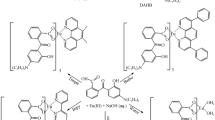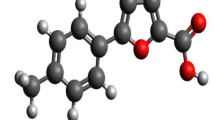Abstract
Preparation and photoluminescence behavior of six new europium complexes with β-diketone 1-(2-hydroxy phenyl)-3-phenylpropane-1,3-dione (HPPP) and bathophenanthroline (batho), 2,2′-bipyridyl (bipy), 2,2′-biquinoline (biq), neocuproin (neo) and 1,10-phenanthroline (phen) are reported in solid state. The ligand (HPPP) and complexes Eu(HPPP)3·H2O (1), Eu(HPPP)3·phen (2), Eu(HPPP)3·batho (3), Eu(HPPP)3·bipy (4), Eu(HPPP)3·biq (5) and Eu(HPPP)3·neo (6) were characterized by means of elemental analysis, infrared spectroscopy, proton nuclear magnetic resonance (1H-NMR). The optical properties, thermal stability and crystalline nature were investigated by photoluminescence spectroscopy, thermogravimetric analysis and XRD respectively. The emission spectra show narrow intense emission band of central europium (III) metal ion that arise from the high intense 5D0 → 7F0 transition. The introduction of ancillary ligands like batho, bipy, biq, neo, phen enlarged the π-conjugation system in complexes as a result higher luminescence intensity, longer life time (τ) and higher quantum efficiency (η) observed in europium ternary complexes in comparison to Eu(HPPP)3·H2O (1). Based on the emission spectra, the luminescence decay curve was measured which indicated that the transfer of energy from HPPP ligand to the europium metal is more efficient in complexes 2–6 than complex 1.








Similar content being viewed by others
References
S.I. Weissman, J. Chem. Phys. 10, 214 (1942)
S.G. Liu, P. He, H.H. Wang, J.X. Shi, M.L. Gong, Mater. Chem. Phys. 116, 654 (2009)
S.G. Liu, M.L. Gong, S. Wang, X.M. Tan, Spectrochim. Acta Part A 74, 731 (2009)
S.G. Liu, P. He, H.H. Wang, J.X. Shi, M.L. Gong, J. Lumin. 130, 855 (2010)
H.H. Wang, P. He, H.G. Yan, M.L. Gong, Sens. Actuators B 156, 6 (2011)
H. Tsukube, M. Hosokubo, M. Wada, S. Shinoda, H. Tamiaki, Inorg. Chem. 40, 582 (2001)
Y.J. Fu, T.K.S. Wong, Y.K. Yan, X. Hu, J. Alloys Compd. 358, 235 (2003)
K. Kuriki, Y. Koike, Y. Okamoto, Chem. Rev. 102, 2347 (2002)
M.R. Robinson, M.B. O’Regan, G.C. Bazan, Chem. Commun. 17, 1645 (2000)
D. Parker, P.K. Senanayake, J.A.G. Williams, J. Chem. Soc. Perkin Trans. 2, 2129 (1998)
C.W. Tang, S.A. Vanslyke, Appl. Phys. Lett. 51, 913 (1987)
J. Kido, K. Nagai, Y. Okamoto, J. Alloys Compd. 192, 30 (1993)
N. Takada, T. Tsutsui, S. Saito, Jpn. J. Appl. Phys. 33, 863 (1994)
B.S. Panigrahi, Spectrochim. Acta Part A 56(7), 1337 (2000)
R. Kumar, J.K. Makrandi, I. Singh, S.P. Khatkar, J. Lumin. 128, 1297 (2008)
X.H. Zhao, K.L. Huang, F.P. Jiao, Z.J. Li, X.H. Peng, Rare Met. 25(2), 144 (2006)
K. Binnemans, K.A. Gschneidner Jr, J.C.G. Bunzil, Rare-Earth Beta-Diketonates, in Handbook on the physics and chemistry of Rare Earths chapter 225, ed. by V.K. Pecharsky (Elsevier, Amsterdam, 2005)
Y.F. Yuan, T. Cadinaels, K. Lunstroot, K. Van Hecke, L. Van Meervelt, C. GÖlrller-Walrand, K. Binnemans, P. Nockemann, Inorg. Chem. 46, 5302 (2007)
F.F. Chen, Z.Q. Bian, Z.W. Liu, D.B. Nie, Z.Q. Chen, C.H. Huang, Inorg. Chem. 47, 2507 (2008)
A. Kumar, J.K. Makrandi, Heteroletters 2(3), 271 (2012)
D. Wang, C. Zheng, L. Fan, J. Zheng, X. Wei, Synt. Met. 162, 2063 (2012)
P.N. Verma, H.D. Juneja, Int. J. Chemtech. Res. 4(3), 1000 (2012)
D. Wang, Y. Pi, C. Zheng, L. Fan, Y. Hu, X. Wei, J. Alloy. Compd. 574, 54 (2013)
V. Divya, S. Biju, R.L. Varma, M.L.P. Reddy, J. Mater. Chem. 20, 5220 (2010)
H.F. Li, P.F. Yan, P. Chen, Y. Wang, H. Xu, G.M. Li, Dalton Trans. 41, 900 (2012)
N. Sabbatini, M. Guardigli, J.M. Lehn, Coord. Chem. Rev. 123, 201 (1993)
H.F. Brito, O.L. Malta, L.R. Souza, J.F.S. Menezes, C.A.A. Carvalho, J. Non-Cryst. Solid 247, 129 (1999)
Acknowledgments
The financial support for this work from Council of Scientific and Industrial Research (CSIR) of India (09/382 (0155)/2012-EMR-I) is highly acknowledged.
Author information
Authors and Affiliations
Corresponding author
Rights and permissions
About this article
Cite this article
Bala, M., Kumar, S., Boora, P. et al. Enhanced optoelectronics properties of europium(III) complexes with β-diketone and nitrogen heterocyclic ligands. J Mater Sci: Mater Electron 25, 2850–2856 (2014). https://doi.org/10.1007/s10854-014-1951-x
Received:
Accepted:
Published:
Issue Date:
DOI: https://doi.org/10.1007/s10854-014-1951-x




